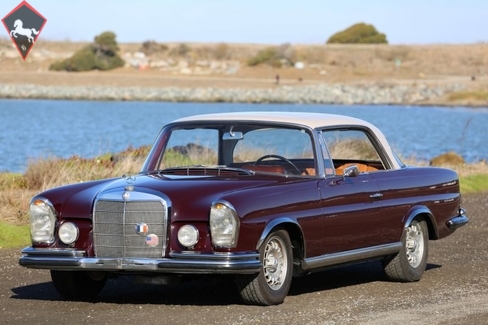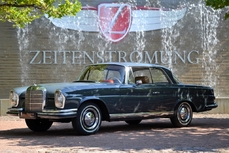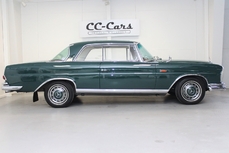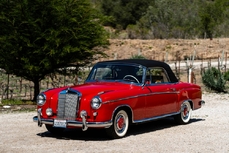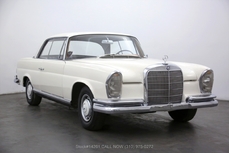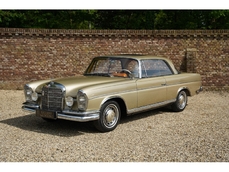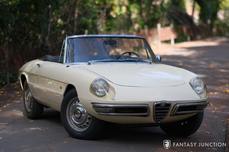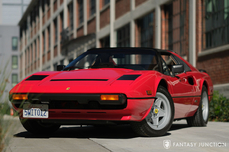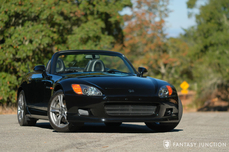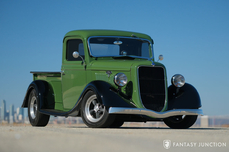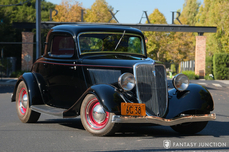Mercedes-Benz 220SE Coupé w111 6.3 liter V8 1964
General description :
***While sold to the current owner by Fantasy Junction, this particular car has not yet arrived into inventory, but is expected during May 2019***
1964 Mercedes Benz 220 SEB 6.3
s/n 11102110067959
Dark Bordeaux Red and Beige Grey with Cognac Leather Interior
In 1961, Mercedes-Benz changed their W111 and W112 generation cars continuing development of the famed “Adenauer” and Ponton cars. In two-door hardtop form, the clean and spacious design delivered the comfort of a closed car with the exhilaration of a convertible. The new cars incorporated a number of advanced technical and convenience features including independent suspension all around, fuel injection, and disc brakes. Powered by robust six cylinder engines, these elegant and luxurious cars were highly sought after and remain so today. In 1969, the line up was further enhanced by the 3.5 V8, which made a notable difference in performance and has since become an iconic version of this body design.
This particular factory sunroof coupe example is presented in dark Bordeaux red with beige grey roof (indicated to be the original exterior colors per the data plate) with leather palomino interior. The car appears to have been well cared for over the past fifty years and this is evident in several areas where original finishes and materials still remain. Some years ago, the six-cylinder engine was removed and an enterprising and thrill-seeking owner speculated on what Mercedes-Benz might have built, installing the powerful and highly desirable 6.3 liter M100 V8 engine originally created for the legendary 600. The conversion was professionally performed using a rebuilt engine with correct Mercedes-Benz parts and components, employing mechanical fuel-injection and a custom exhaust. During the conversion, particular care was given to upgrade motor mounts and front suspension in order to properly mount and distribute the power delivered from the robust and capable V8 engine. Additional work included a rebuilt and calibrated fuel-injection pump, new cold start valves and relays, new fuel lines and fuel filter, new oil cooler hoses, and new power steering pump seals. The car was further updated with new leather upholstery on the seats (other than the horizontal surface of the back seats) using correct leather and new carpeting. A new Bosch starter, battery, and factory bundt alloy wheels. The car was also updated with new door, taillight and headlight rubber seals, a new package tray, and floor mats. The front brakes were rebuilt in 2013 about 300km ago. At that time, all four shocks were replaced and the car received a general service including oil change and fluid level inspection.
Today the car presents nicely with driver quality paint and condition that invites enjoyable, stately touring without the fuss associated with a show car. The paint has good gloss and a pleasing finish overall with some minor blemishes. Much of the chrome plating has been recently done to a good standard, with the roof and window garnish moldings properly polished and tidy. Doors, hood, and trunk close tightly and hold good panel gaps overall. The glass, lenses, and trim present in similar condition to the overall look of the car, making a cohesive and satisfying presence one can immediately enjoy. Close inspection reveals some aging to the rubber weatherstripping around the windscreens, as well as some wear to the front windscreen.
The interior has been recently redone with leather properly sourced and matched to original Mercedes-Benz materials. The front seats and rear seat back were recovered, however the rear seat bottom was not reupholstered and shows some aging. The door panels, interior side panels, and headliner are nicely finished and the carpeting has been replaced using high quality materials. The dashboard has been refinished, housing very nice instruments showing clear dials and crisp lettering. The steering wheel rim has a number of cracks. The wood on the dashboard has been refinished with glossy coating, however is not to show standard and is showing some cracks on the top of the instrument binnacle and the trim at the base of the front windscreen. Inside the trunk compartment, the spare tire, jack, and correct rubber floor mat are clean and tidy, very likely original and un-restored, but still very serviceable.
The engine compartment is impressively tidy and the M100 V8 looks very much at home. The installation was done to high standards, with a factory appearance. Attention to period correct details appears to have been paid whenever possible and the engine and associated components are clean and correct. The engine compartment is tidy and properly maintained showing clean finishes reflective of original castings and hardware, with moderate updating to improve reliability. The underside of the car is clean and solid, with no noted significant structural corrosion noted.
The car is extraordinarily amusing to drive. The experience is dominated by the engine, which thanks to dual exhaust and glass packs, sounds suitably stout. It is not as loud as an American muscle car of the period, but is appreciably louder than a stock 6.3. Progress is considerably more brisk than a 300 SEL 6.3, and there is an urgency to the car’s manner which inspires a grin from the driver and is vaguely reminiscent of some of today’s performance sedans. The shifts from the gearbox are positive but smooth, the brakes are effective, and the overall feel of the car is coherent. The suspension is compliant and the steering light. The car can be placed with accuracy and any fears caused by the large V8 over the front wheels are quickly dispelled by a drive around the block. Coupled with the open air sensations and elegance of the pillarless construction, the performance of the car gives it a duality that will appeal to the enthusiast who also values understatement. At this time, both the fuel gauge and tachometer are inoperable.
The car is accompanied by several original factory documents, however many of these documents appear to be correct factory literature, but are not specific to this car. Documents include an original vinyl owners pouch with an original owners manual, service booklet (with entries and stamps), US authorized dealer locator booklet, original 220SE parts catalog, and multiple original Becker radio documents. Also included are various factory brochures, reference literature, newer parts catalogs, and some service records.
Nicely presented and wonderfully updated with the legendary 6.3 V8 engine, this factory sunroof coupe in wonderful colors and trim, is ready for enjoyable driving. Prepared with Mercedes-Benz parts and thoughtful engineering, this V8 hardtop is an enchanting vision of what might have been constructed at the factory had the power of the 6.3 liter V8 been combined with the classic lines of the 220 SE.
http://fantasyjunction.com/cars/2043-Mercedes-Benz-220%20SEB%206.3%20Conversion-6.3%20liter%20V8
1964 Mercedes-Benz 220SE Coupé w111 6.3 liter V8 is listed sold on ClassicDigest in Emeryville by Fantasy Junction for $52500.
Car Facts
Car type : Car Make : Mercedes-Benz Model : 220SE Coupé w111 Model Version : 6.3 liter V8 Engine size : 6.3 Model Year : 1964 Location : Emeryville
Sold
Seller Information
Sold
People who viewed this Mercedes-Benz 220SE Coupé w111 also viewed similar Mercedes-Benz listed at ClassicDigest
Other cars listed for sale by this dealer
About Mercedes-Benz
In the annals of automotive history, the journey of Mercedes-Benz is a tale that unfolds with the ingenuity of its founding pioneers. In the year 1886, Karl Benz crafted the Benz Patent Motorwagen, a creation that would go down in history as the world's inaugural automobile. Unbeknownst to him, this moment marked the genesis of what would evolve into the most illustrious premium car manufacturer globally. The financial underpinning of this pioneering venture, interestingly, was provided by Karl Benz's wife, Bertha Benz, demonstrating a remarkable partnership that would set the tone for Mercedes-Benz's legacy.A parallel narrative emerged not far away, as Daimler-Motoren-Gesellschaft, founded by Gottlieb Daimler and Wilhelm Maybach, entered the scene. In 1901, they unveiled their automobile under the now-famous moniker "Mercedes," meaning "godsend" in Spanish. This name was bestowed upon the car at the behest of Emil Jellinek's daughter, the distributor for Daimler-Motoren-Gesellschaft. The wheels of innovation were set in motion.
Fast forward to 1926, a pivotal year that witnessed the merger of Daimler with Benz & Cie., culminating in the birth of Daimler-Benz. The amalgamation saw the adoption of "Mercedes-Benz" as the distinguished trademark for their automobiles, fusing the legacies of two visionary entities into one.
Contrary to perceptions of conservatism, the trajectory of Daimler-Benz unfolds as a chronicle of industry firsts. From the introduction of the honeycomb radiator to the float carburetor, and the pioneering implementation of four-wheel brakes in 1924, Daimler-Benz consistently pushed the boundaries of automotive innovation. The diesel-powered Mercedes-Benz 260 D in 1936 marked the inception of diesel engines in passenger cars. The iconic Mercedes-Benz 300SL Gullwing made history as the first car with direct fuel injection, albeit the Gutbrod's tiny 2-stroke engine can claim precedence.
Safety innovations became a hallmark, with Béla Barényi's patented safety cell design in the "Ponton"-models in 1951, featuring front and rear crumple zones. The W116 450SEL 6.9 saw the introduction of the Anti-Lock Brake system (ABS), another pioneering safety feature. From the first production airbags and beyond, the legacy of "firsts" continued to be etched into the fabric of Daimler-Benz.
Over its centennial journey, Mercedes-Benz has not merely produced cars but has sculpted automotive icons. The SSKL, 710 SSK Trossi Roadster, 770K Grosser, 540K Spezial Roadster, 300SL Gullwing, w100 600 Pullman, w111 280SE 3.5 Flachkühler, w113 230SL Pagoda, w109 300 SEL 6.3, and w201 2.3-16 Cosworth stand testament to the brand's commitment to engineering excellence.
The roaring Silver Arrows, or "Silberpfeile," including the W 25, W 125, W154, W165, and W196, created a legacy of dominance on the racetrack. These machines were not merely cars; they were expressions of precision, speed, and an indomitable spirit that left their competitors in the dust.
As Mercedes-Benz marches into the future, it does so not just as an automaker but as a custodian of a legacy, a torchbearer of innovation, and a beacon of automotive excellence. The road ahead is sure to witness the continued fusion of cutting-edge technology, timeless design, and an unwavering commitment to setting new standards in the world of automobiles.
One luminary figure who left an indelible mark was Béla Barényi, often heralded as the "father of passive safety" for his pioneering work in safety engineering. His patented safety cell design, featuring front and rear crumple zones, became a hallmark of Mercedes-Benz's commitment to occupant safety, setting new standards that reverberated throughout the automotive world.
Moving through the chronicles, the collaborative genius of Wilhelm Maybach, alongside Gottlieb Daimler, laid the foundation for Daimler-Motoren-Gesellschaft. Their innovations not only birthed the first Mercedes but established a culture of relentless pursuit of technological excellence that remains integral to Mercedes-Benz's DNA.
In the post-merger era of 1926, Ferdinand Porsche emerged as a prominent figure within Mercedes-Benz. His work on the Mercedes-Benz S-Type, a supercharged race car, garnered acclaim and set the stage for a legacy that extended far beyond the marque. Porsche's impact would later extend to his eponymous company, but his influence at Mercedes-Benz during those formative years was pivotal.
As the 20th century progressed, the legendary Rudolf Uhlenhaut emerged as a key figure. Uhlenhaut, an accomplished engineer and the driving force behind the iconic Silver Arrows, played a crucial role in Mercedes-Benz's dominance in motorsports. His engineering prowess and attention to detail were instrumental in creating some of the most formidable racing cars of the era.
In the latter half of the century, figures like Bruno Sacco, the head of design at Mercedes-Benz from 1975 to 1999, left an indelible imprint on the brand's aesthetic identity. Sacco's design philosophy, characterized by clean lines and timeless elegance, shaped iconic models like the W126 S-Class and the W201 190E, solidifying Mercedes-Benz's reputation for luxury and sophistication.
The narrative would be incomplete without acknowledging the contributions of engineers like Hans Scherenberg, whose leadership in the 1970s ushered in a new era of technological innovation at Mercedes-Benz. Scherenberg's tenure saw the development of groundbreaking technologies, including the Anti-Lock Brake system (ABS) and the introduction of airbags in production cars.
